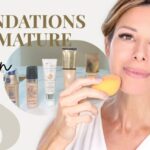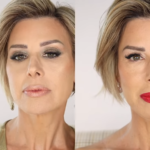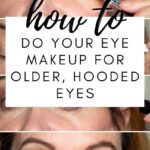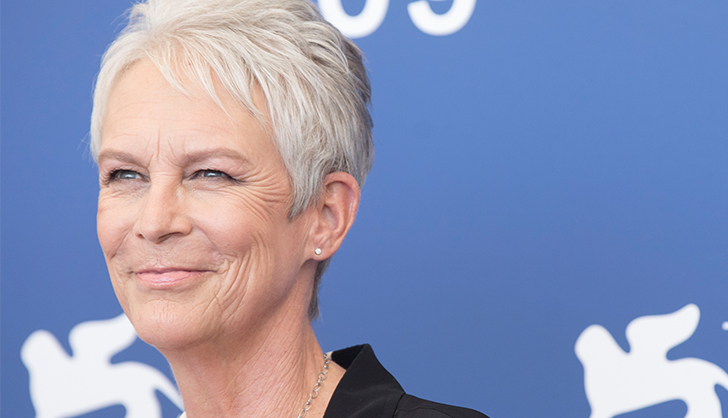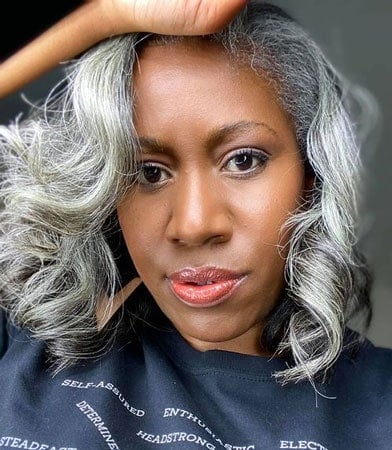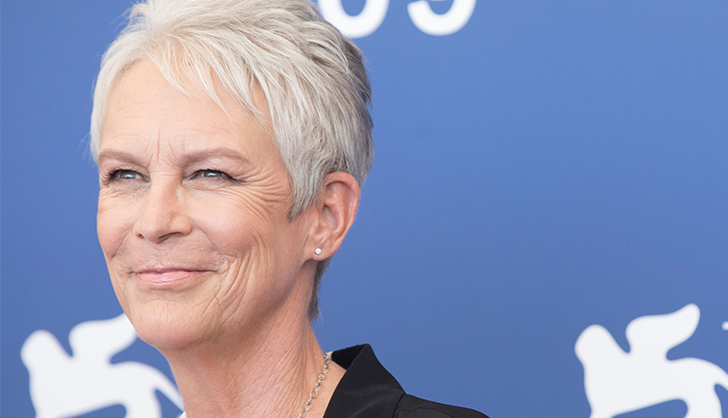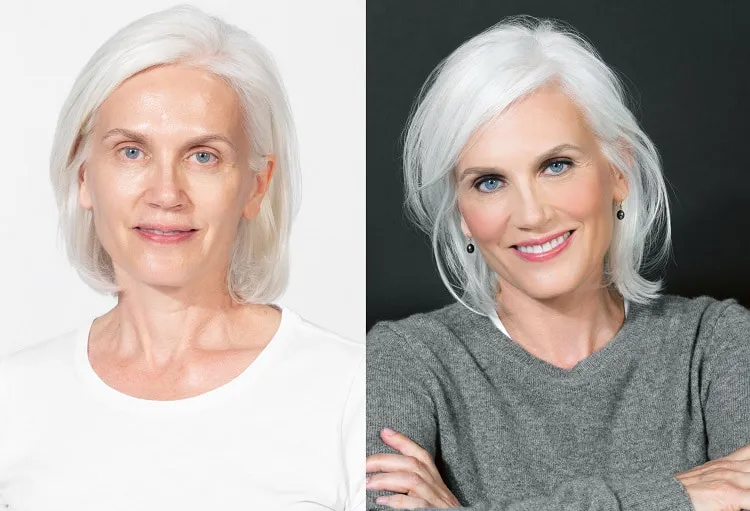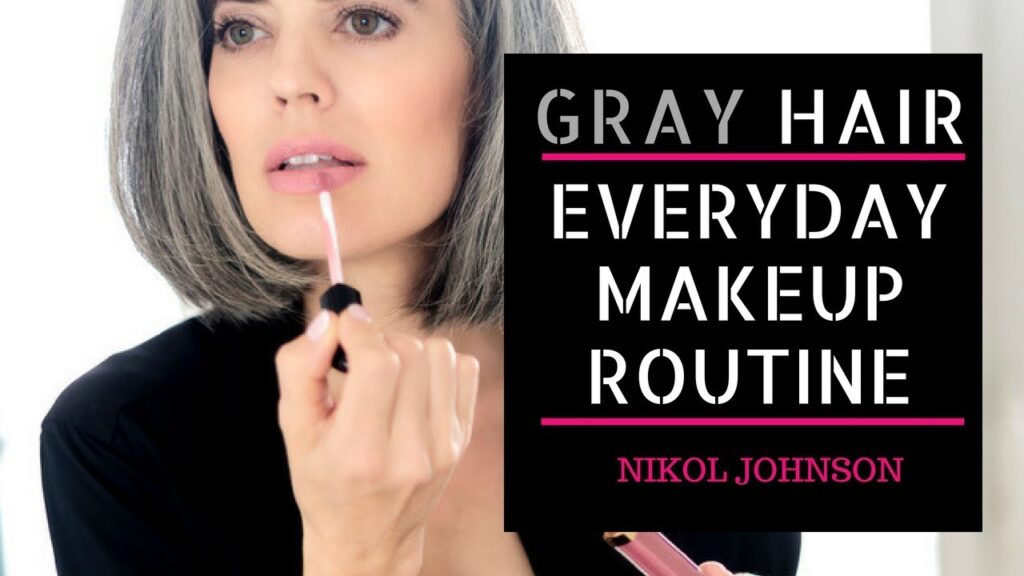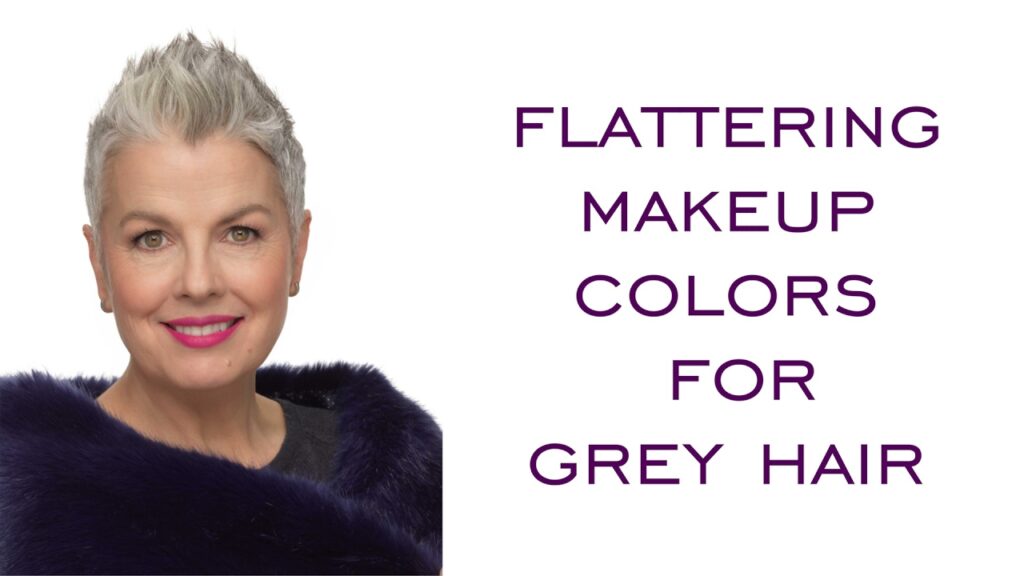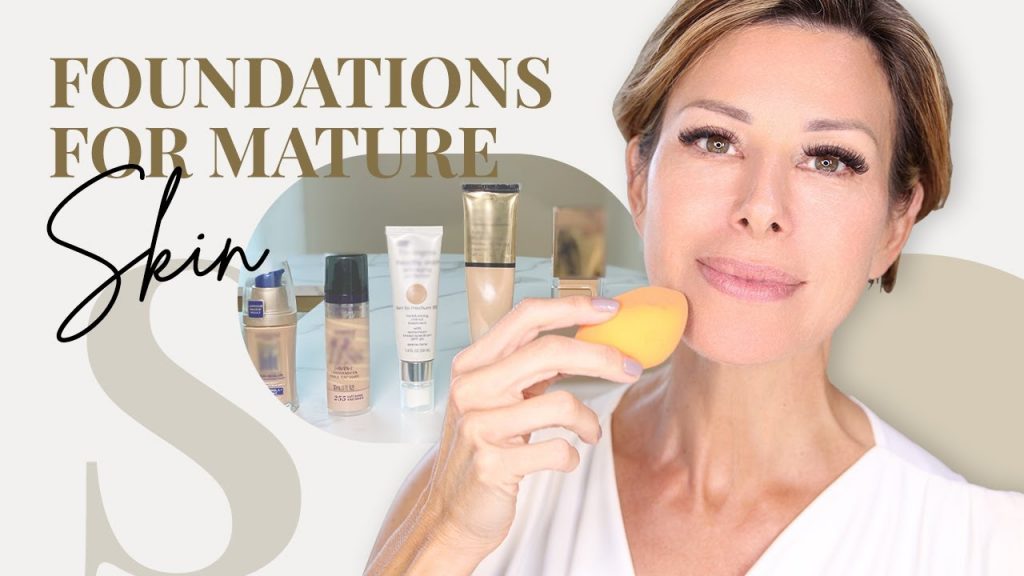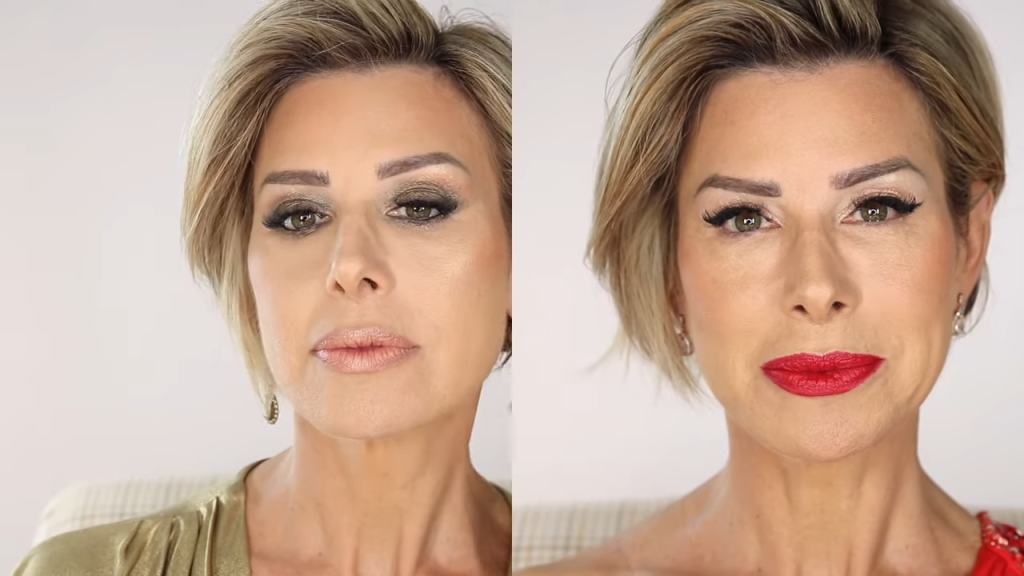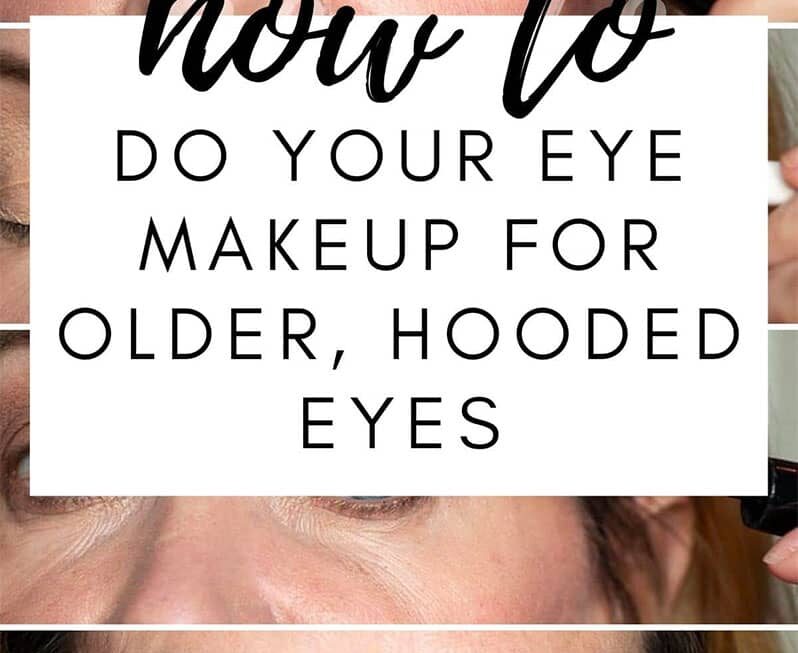Are you a woman over 50 with gray hair and looking for makeup tips to enhance your natural beauty? In this article, we will explore the best makeup techniques and products that will help you feel confident and radiant. Whether you want to embrace the silver strands or add some color to your look, we have got you covered. Get ready to discover the secrets of makeup for gray hair over 50 and enhance your beautiful, mature features.
Determining the Right Colors
Understanding the Undertones of Gray Hair
As you age, your hair may naturally start to turn gray. Gray hair can have different undertones, such as silver, ash, or even slightly blue or purple hues. Understanding the undertones of your gray hair is essential for choosing makeup shades that complement it. Silver-gray hair often pairs well with cool-toned makeup, while ash-gray hair can be complemented by both warm and cool tones. By identifying the undertones in your gray hair, you can select makeup shades that enhance your natural beauty.
Choosing Makeup Shades that Complement Gray Hair
When it comes to choosing makeup shades for gray hair, the key is to create a harmonious look that enhances your features while complementing the color of your hair. As a general guideline, cool-toned makeup shades, such as soft pinks, plums, and blues, often work well with silver or ash-gray hair. Neutral tones, like taupes and mauves, can also be flattering. Warm tones, such as peachy pinks and golden browns, can add warmth and vibrancy to gray hair with warm undertones. Ultimately, the best makeup shades for you will depend on your personal preferences and the overall look you want to achieve.
Identifying the Best Foundation Shade for Gray Hair
Choosing the right foundation shade is crucial for creating a flawless base that matches your natural skin tone and complements your gray hair. Gray hair can sometimes make your skin appear paler, so it’s essential to find a foundation shade that adds some warmth and vitality back into your complexion. Opt for foundations with yellow or peach undertones to counteract any dullness or sallowness that may accompany gray hair. Testing the foundation shade on your jawline in natural light can help ensure a seamless match. Remember to blend well and choose a formula that suits your skin type for a long-lasting and natural-looking finish.
Creating a Flawless Base
Prepping the Skin
Before applying any makeup, prepping your skin is key to achieving a flawless base. Start by cleansing your face to remove any impurities and ensure a clean canvas. Follow up with a lightweight moisturizer to hydrate your skin and create a smooth surface for makeup application. Additionally, using a primer specifically designed for mature skin can help fill in fine lines and wrinkles, minimize the appearance of pores, and enhance the longevity of your makeup.
Using Primers to Achieve a Smooth Canvas
Primers are an excellent tool in your makeup routine, especially when it comes to achieving a smooth canvas for mature skin. Look for primers that contain hydrating ingredients to combat dryness and primers with blurring properties to minimize the appearance of fine lines and wrinkles. Apply a small amount of primer all over your face or concentrate on areas of concern, such as around the nose or on the forehead. By using a primer, you create a silky and even base that helps your foundation and other makeup products glide on seamlessly.
Choosing the Right Foundation and Application Technique
When it comes to choosing the right foundation for mature skin, look for formulas that offer hydration, luminosity, and medium to full coverage. Foundations with a dewy or satin finish can help add radiance to dull skin, while formulas with anti-aging properties can provide additional skincare benefits. As for the application technique, try using a damp makeup sponge or a dense brush to achieve an airbrushed finish. Apply the foundation in thin, even layers, building up the coverage gradually. This technique helps avoid a heavy or cakey appearance.
Concealing Under-eye Circles and Age Spots
Concealing under-eye circles and age spots is an important step in creating a flawless base. Opt for a creamy concealer that matches your skin tone or is slightly lighter. Apply the concealer under your eyes to brighten and minimize the appearance of dark circles. Dab a small amount of concealer on any age spots or hyperpigmentation, gently blending the edges for a seamless finish. Set the concealer with a translucent powder to prevent creasing and ensure long-lasting coverage.
Enhancing the Eyes
Defining the Brows
Well-defined eyebrows can frame your face and give a polished look. As your hair turns gray, your eyebrows may also lighten or lose pigment. To define your brows, choose a brow product that matches your natural hair color. If your gray hair has cool undertones, opt for an eyebrow product with ashy tones. For warm undertones, choose a product with warmer undertones. Fill in any sparse areas using short, feathery strokes to mimic natural hair and create a soft, natural look.
Selecting Eye Shadow Shades to Accentuate Gray Hair
When selecting eye shadow shades to accentuate gray hair, consider colors that complement your skin tone and the undertones in your hair. Cool-toned eye shadows, such as soft grays, taupes, and blues, can enhance silver or ash-gray hair. Warm-toned shadows, like golden browns or soft pinks, can add warmth and vibrancy to gray hair with warm undertones. Experiment with different shades and textures to find what works best for you. Matte and satin finishes can be flattering for mature eyes, as they offer a more subtle and refined look.
Applying Eyeliner and Mascara for a Youthful Look
Eyeliner and mascara can make your eyes appear more vibrant and youthful. When it comes to eyeliner, opt for softer shades, such as gray or brown, rather than harsh black. Apply a thin line close to the lash line to define your eyes without overwhelming them. To further enhance your lashes, choose a volumizing or lengthening mascara. Apply a few coats, focusing on the roots and wiggling the wand through the lashes for a lifted look. Mascara can help open up your eyes and create a more awake and refreshed appearance.
Tips for Dealing with Fine Lines around the Eyes
Fine lines around the eyes are a natural part of the aging process. To make your eye makeup look seamless, gentle techniques and the right products are key. Start by using a hydrating eye cream to moisturize the delicate skin around the eyes. Avoid applying heavy eyeshadow or thick eyeliner on the crepey areas, as this can emphasize wrinkles. Instead, choose a light-handed approach and opt for softer, satiny textures. Consider using a primer specifically formulated for the eye area to smooth out the skin and create an even surface for makeup application.
Adding Color to the Cheeks
Selecting Blush Shades for Gray Hair
Choosing the right blush shades can add a healthy flush of color to your complexion and complement your gray hair. Cool-toned gray hair can be beautifully enhanced by soft pinks, mauves, and plums. Warm-toned gray hair can be complemented by peachy pinks, corals, and warm rose shades. Consider your skin tone and undertones when selecting blush shades for the most flattering result. Remember to start with a light hand and build up the color gradually for a natural-looking flush.
Applying Blush to Add a Pop of Color and Radiance
To apply blush, smile to identify the apples of your cheeks, and gently sweep the blush onto them using a fluffy brush. Blend the color upwards and outwards towards the temples for a natural-looking flush. A little goes a long way, so start with a small amount of blush and add more if desired. Avoid dragging the brush or applying too close to the nose, as this can emphasize redness or widen the appearance of the face.
Contouring Techniques to Define Facial Structure
Contouring can help define your facial structure and add dimension to your face. Choose a cool-toned contour shade that is a few shades darker than your natural skin tone. Apply the contour product with a brush or sponge in the hollows of your cheeks, along the jawline, and on the sides of your nose to create the illusion of shadows. Blend well to ensure a seamless and natural-looking contour. This technique can help enhance your features and create a more sculpted appearance.
Highlighting for a Subtle Glow
Adding a touch of highlighter can bring radiance and a youthful glow to your complexion. Choose a highlighter shade that complements your skin tone; champagne, soft gold, and rose gold shades are popular choices. Apply the highlighter to the high points of your face, such as the cheekbones, brow bone, and the tip of your nose. This will create a subtle luminosity that catches the light and enhances your features. Be careful not to overdo it, as too much highlighter can emphasize texture and fine lines.
Accentuating the Lips
Choosing Lipstick Shades that Complement Gray Hair
Finding the right lipstick shades can be a fun way to add a pop of color to your makeup look and complement your gray hair. Soft pinks, rosy nudes, and mauves can add a natural-looking flush of color. For a bolder look, consider deep berry tones or vibrant reds. When selecting lipstick shades, take into consideration your skin tone and undertones, as well as personal preferences. Feel free to experiment with different colors to find what makes you feel confident and beautiful.
Achieving a Fuller Look with Lip Liner
If you want to achieve a fuller look, lip liner can be a valuable tool. Choose a lip liner that matches your natural lip color or the shade of your lipstick for a seamless result. Start by lining your lips, slightly overlining if desired to create the illusion of fuller lips. Then, fill in your lips entirely with the lip liner before applying your lipstick. This technique helps create a long-lasting base and prevents the lipstick from feathering or bleeding throughout the day.
Tips for Preventing Lipstick from Feathering and Bleeding
To prevent lipstick from feathering or bleeding into fine lines around the lips, a few simple steps can help ensure a neat and polished finish. First, exfoliate your lips regularly to remove any dry or flaky skin. Next, apply a lip primer or a small amount of foundation to the lips to create a smooth base. Consider using a long-wearing or matte lipstick formula, as these tend to have better staying power. Finally, apply a lip liner all over your lips as a base, and fill in your lips entirely with the liner before applying lipstick. Blot your lips with a tissue and reapply a second layer of lipstick for a longer-lasting result.
Adding a Glossy Finish for a Youthful Appearance
A glossy finish can add a youthful and fresh look to your lips. To achieve this, opt for a moisturizing lip gloss in a shade that complements your lipstick or natural lip color. Apply the lip gloss to the center of your lips and gently blend it out for a luscious, plump effect. This technique helps reflect light and create the illusion of fuller lips. If you prefer a more subtle shine, dab a small amount of lip gloss on the center of your bottom lip and press your lips together for a natural-looking sheen.
Dealing with Common Aging Skin Concerns
Minimizing the Appearance of Fine Lines and Wrinkles
Fine lines and wrinkles are common aging skin concerns, but there are ways to minimize their appearance using makeup. Avoid heavy, thick textures that can settle into lines and emphasize them. Instead, opt for lightweight, hydrating formulas that can plump up the skin and create a smoother canvas. Consider using a color corrector to neutralize any discoloration or redness that may accompany fine lines. By using the right products and techniques, you can create a more youthful and radiant complexion.
Addressing Dryness and Hydrating the Skin
Dryness is another common concern as your skin ages. To address dryness and hydrate the skin, incorporate moisturizing products into your skincare routine. Look for hydrating foundations, concealers, and blushes that contain ingredients like hyaluronic acid or glycerin. These products can help lock in moisture and give your skin a plump and dewy appearance. Additionally, using a setting spray or facial mist throughout the day can help refresh your makeup and provide an extra boost of hydration.
Choosing Cream-based Products for Mature Skin
Cream-based products often work well for mature skin, as they have a hydrating and dewy finish that can help minimize the appearance of fine lines and provide a more youthful glow. Consider using cream blushes, highlighters, and eyeshadows for a seamless and natural look. Cream products are also easier to blend and build up gradually, allowing you to customize the intensity of the colors. Experiment with different cream-based formulas to find the ones that work best for your skin type and desired look.
Camouflaging Age Spots and Hyperpigmentation
Age spots and hyperpigmentation can be camouflaged using the right makeup products and techniques. Start by applying a color corrector in a shade that counteracts the discoloration. For example, a peach or orange corrector can help neutralize dark spots or hyperpigmentation. Apply a small amount of corrector to the affected areas and gently blend it out. Follow up with a foundation or concealer that matches your skin tone, applying it on top of the corrector. Set the area with a light dusting of translucent powder to ensure long-lasting coverage.
Avoiding Makeup Mistakes
Not Overdoing the Foundation
One common makeup mistake is applying too much foundation, which can result in a heavy and unnatural appearance. Instead, aim for a lightweight and natural look that enhances your features. Start with a small amount of foundation and build up the coverage gradually, focusing on areas where you need it most. Avoid applying foundation all over your face if you don’t require full coverage, and opt for a lighter formula or a tinted moisturizer for a more natural finish. Remember, less is often more when it comes to makeup for mature skin.
Avoiding Heavy Eye Makeup
Heavy eye makeup can appear overwhelming and draw attention to fine lines and wrinkles. Instead, opt for a more subtle and refined look that enhances your eyes without overpowering them. Focus on defining your lashes, using neutral or soft-toned eyeshadows, and applying eyeliner close to the lash line. These techniques can make your eyes appear brighter and more youthful without emphasizing any texture or crepiness around the eyes.
Avoiding Vibrant, Harsh Lipstick Shades
While experimenting with lipstick shades is fun, it’s important to avoid vibrant or harsh colors that can age you or draw attention to fine lines around the mouth. Opt for softer, more muted shades that complement your skin tone and gray hair. Neutral pinks, rosy nudes, and soft reds are generally flattering options. Remember that the goal is to enhance your natural beauty and create a harmonious look rather than overpowering or overpowering your features.
Avoiding Shimmer and Glitter Products
Shimmer and glitter products can draw attention to fine lines, wrinkles, and textured areas on the skin. While a subtle shimmer can add a youthful glow, it’s best to avoid excessive glitter or shimmer on mature skin. Opt for satin or matte finishes for a more refined and natural look. If you do want to incorporate some shimmer, choose products with finely milled shimmer particles that create a subtle sheen rather than visible glitter. By selecting the right textures and finishes, you can enhance your features without emphasizing any undesirable skin texture.
Taking Care of Gray Hair
Keeping Gray Hair Healthy and Shiny
Maintaining healthy and shiny gray hair is essential for a youthful appearance. Gray hair can sometimes be more prone to dryness and dullness. To keep your hair looking its best, use a gentle shampoo and conditioner specifically formulated for gray or color-treated hair. These products can help preserve the natural shine and vibrancy of your gray hair. Additionally, consider incorporating a weekly hair treatment or mask to add extra moisture and nourishment to your hair.
Choosing the Right Hair Care Products
Choosing the right hair care products can make a significant difference in the health and appearance of your gray hair. Look for sulfate-free shampoos and conditioners that are formulated to hydrate and add shine to gray hair. Consider using a purple shampoo every few washes to prevent any unwanted yellow or brassy tones in your gray hair. Using a leave-in conditioner or hair oil can also help keep your hair moisturized and tangle-free, creating a smoother and more lustrous look.
Styling Tips for Gray Hair
When it comes to styling gray hair, there are various options to consider. Embracing your natural hair texture can be a great choice, as it requires less heat styling and can showcase the uniqueness of your gray hair. If you prefer to style your hair, consider using a heat protectant spray before using hot tools to minimize damage and breakage. Experiment with different hairstyles, such as soft waves, sleek pixies, or chic updos, to find what suits you and enhances your overall look.
Understanding the Impact of Hair Color on Makeup Choices
It’s essential to consider the impact of your hair color on your makeup choices. Gray hair can create a soft and elegant backdrop, allowing you to experiment with various makeup shades. As you transition to gray hair, you may find that some makeup colors that once suited you no longer have the same effect. Consider adjusting your makeup palette to complement your new hair color. Take into account the undertones of your gray hair and experiment with different shades to find what enhances your natural beauty.
Modifying Makeup Techniques for Aging Skin
Applying Makeup to Minimize Wrinkles
Makeup techniques can be modified to minimize the appearance of wrinkles. Instead of using heavy or matte formulas that settle into fine lines, opt for hydrating and dewy foundations that glide over the skin. Apply foundation with a damp makeup sponge or a brush, focusing on pressing the product into the skin rather than dragging it. Avoid heavy powder application, as it can settle into lines and emphasize texture. By using lighter textures and adopting a more gentle application technique, you can create a more youthful and radiant appearance.
Using Lighter Textures and Finishes
Using lighter textures and finishes can create a more natural and youthful look. As we age, our skin texture can change, and heavy or matte makeup can sometimes emphasize fine lines and wrinkles. Opt for lightweight formulas, such as tinted moisturizers, BB creams, or sheer foundations that provide a natural-looking coverage. Satin or dewy finishes can add a healthy glow to mature skin, while mattifying products should be used sparingly or only where necessary to avoid a flat and dull look.
Blending Techniques for a Natural Look
Blending is key to achieving a natural-looking makeup application, especially when it comes to mature skin. Use gentle and circular motions with a brush, sponge, or even your fingers to blend products seamlessly into the skin. Pay extra attention to areas where the skin may have more texture, such as around the eyes or mouth. By taking the time to blend your makeup well, you can achieve a smooth and natural finish that enhances your features while minimizing the emphasis on any fine lines or textured areas.
Avoiding Cakey and Heavy Makeup
Avoiding cakey and heavy makeup is essential for a youthful appearance. Heavy applications of foundation, concealer, or powder can settle into fine lines and wrinkles, creating a noticeable and unnatural look. Opt for sheer or buildable products and apply them with a light hand. Choose cream or liquid formulas over powders whenever possible, as they tend to blend more seamlessly into the skin. Prioritize skincare and focus on creating a healthy and radiant complexion, so you can confidently wear minimal makeup if desired.
Seeking Professional Advice
Consulting a Makeup Artist
If you’re uncertain about how to choose the right makeup shades or techniques for your gray hair and mature skin, consider consulting a professional makeup artist. A makeup artist can assess your unique features and provide personalized recommendations for makeup colors, products, and application techniques. They can help you create a customized beauty routine that enhances your natural beauty and makes you feel confident and beautiful. Don’t hesitate to ask questions and communicate your preferences to ensure the best outcome.
Visiting a Dermatologist for Skincare Recommendations
When dealing with common aging skin concerns and selecting skincare products, it’s beneficial to consult a dermatologist. A dermatologist can evaluate your skin type, address specific concerns like fine lines, wrinkles, or hyperpigmentation and recommend specialized skincare products or treatments. They can also provide guidance on maintaining a healthy skincare routine that complements your makeup application. Seeking professional advice from a dermatologist can help you achieve optimal skin health and a more youthful appearance.
Seeking Hair Stylist’s Opinion for Hair and Makeup Harmony
To achieve a harmonious look between your hair and makeup, consider seeking your hair stylist’s opinion. They can provide guidance on hair color, cut, and styling techniques that complement your gray hair and enhance your overall look. By consulting with a hair stylist, you can create a cohesive and balanced appearance that ties in your hair and makeup choices. Collaborating with professionals who specialize in hair color and makeup can ensure that you achieve the desired outcome and feel confident in your appearance.
Taking Advantage of Makeup Consultations at Beauty Counters
Many beauty counters offer complimentary makeup consultations where you can receive personalized advice and try out different products. Take advantage of these opportunities to explore new makeup shades, learn application techniques, and gain insights from beauty experts. Beauty consultants can help you navigate the vast array of products and assist in selecting the ones that are best suited for your gray hair and mature skin. These consultations are a fantastic way to update your makeup routine and discover new products that enhance your natural beauty.
In conclusion, makeup for gray hair over 50 can be a wonderful way to enhance your natural beauty and boost your confidence. By understanding the undertones of your gray hair and selecting colors that complement them, you can create a harmonious look that highlights your features. Creating a flawless base involves prepping your skin, using primers, choosing the right foundation shades, and concealing any imperfections. Enhancing the eyes can be achieved through defining the brows, selecting eye shadow shades, and applying eyeliner and mascara. Adding color to the cheeks involves selecting blush shades, applying blush, contouring the face, and highlighting for a subtle glow. Accentuating the lips requires choosing lipstick shades, using lip liner, and preventing lipstick from feathering. Dealing with common aging skin concerns involves minimizing the appearance of fine lines and wrinkles, addressing dryness, choosing cream-based products, and camouflaging age spots and hyperpigmentation. Avoiding makeup mistakes includes not overdoing the foundation, avoiding heavy eye makeup, vibrant lipsticks, and shimmer and glitter products. Taking care of gray hair involves keeping it healthy and shiny, choosing the right hair care products, styling tips, and understanding the impact of hair color on makeup choices. Modifying makeup techniques for aging skin involves applying makeup to minimize wrinkles, using lighter textures and finishes, blending techniques, and avoiding cakey and heavy makeup. Seeking professional advice from makeup artists, dermatologists, hair stylists, and beauty counters can provide valuable insights and recommendations tailored to your specific needs. By following these tips and customizing your makeup routine, you can embrace your gray hair and age gracefully while looking and feeling your best.



